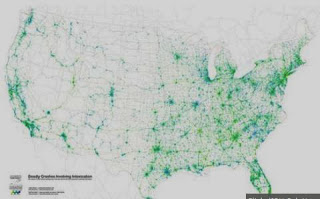Image above: The power of nature to fight back!
An interesting angle on human rights and the environment
Last week I worked with my Year 12 Society and Culture students on presenting an oral as an advocate for human rights. Matthew, one of my students developed a paper that argued that the ultimate human right is the protection of the environment. Only a night or two before I had watched David Suzuki on Q&A argue a similar line when he said:
"I believe what's going on now is criminal, our activity, because it's a crime against future generations," Suzuki said. "And there ought to be a legal position of inter-generational crime. And I think there's criminal negligence."
Here is the transcript of the oral Matthew presented to the class with great passion and thought. An interesting and I would say important angle when we talk about human rights, particularly in a geography class!
Human Rights: more than just sweatshops!
The right to life is our most important right of all. Without
it, all others rights do not exist.
This is a right that all human beings are entitled to.
Of course, with all rights come responsibilities. However, we
as humans have neglected our responsibility of ensuring that this right to life
is passed on to future generations.
Now this may sound a tad extreme, but we are destroying the
future of future generations and our most important asset of all, the
environment.
When many people think of the health of the environment,
they think of it as merely the well-being of plants and trees. But they fail to realise that it is also a
critical human rights issues and that our quality of lives are deeply affected
by it.
According to a report conducted by the United Nations International Panel on Climate Change, human
activity has caused at least half of climate change in the last half century.
The report has also stated that the world is getting hotter,
sea levels are rising and there are natural disasters occurring more frequently
causing unnecessary deaths of many around the world. So when we harm the environment, we in turn, also harm
humans. The health of the Earth affects the health of the human race.
Article 23 of Universal Declaration of Human Rights states;
‘Everyone
has the right to a standard of living adequate for the health and well-being of
himself and of his family’.
But if we continue to decimate the environment, people in
the future will not have this fundamental right.
Today I would like to introduce a newly created term with
you all, Ecocide. Ecocide is the biggest threat to the human race on this
planet. But what is Ecocide you may ask?
Ecocide is the extensive damage
to, destruction of or loss of ecosystem(s) of a given territory, whether by
human agency or by other causes, to such an extent that peaceful enjoyment by
the inhabitants of that territory has been or will be severely diminished.
The most disturbing aspect of Ecocide is that it can be
irreversible when an ecosystem suffers beyond self-healing.
It’s also important to note when speaking about ecocide,
that is a problem facing the entire world. Ecocide is happening right now as we speak. Around
the world, businesses are destroying our environment, doing everything they can
to make a profit.
Deforestation, which is the removal of forest that is then
converted to a non-Forrest area, oil spills, toxic dumping, deep water mining
are all of examples of Ecocide that are occurring around the globe. These procedures are not only harming the environment, but
also our quality of life. Throughout history there have been conflicts over the
control of natural resources such as diamonds, coal and oil which have seen the
destruction of the environment and loss of many lives.
If our most basic resources become more scarce around the
world, then it would seem likely that just in just a few generations time,
countries could be waging wars over our most basic needs such as food and
water.
So that’s why I am advocating for the implementation for a
law that makes the destruction of our environment a crime, and for the crime of
ecocide to be added to the list of international crimes against peace. Now that might seem like a fairly ambitious goal, but I
believe, if enough people can get the United Nations to take notice of this issue,
and make ecocide an official crime, we can eradicate ecocide.
If Ecocide is eradicated, business and governments around
the world, who are committing ecocide, will use environmentally friendly means
to conduct their business.
If Ecocide is eradicated, the world will become a cleaner
and safer place to live.
If ecocide is eradicated, people will live longer and
healthier lives.
But we can only achieve this if each and every one of us
takes on board the responsibility on preserving the environment. If it’s
something small like putting recyclable material in the recycling, or taking
public transport to work one a week instead of driving to work and polluting
the air, we can all play a role in preserving the health the of OUR
ENVIRONMENT.
By doing this, we will ensure that next generation will be
able to have the great quality of life that we have today, and so will the
generations to come.




















